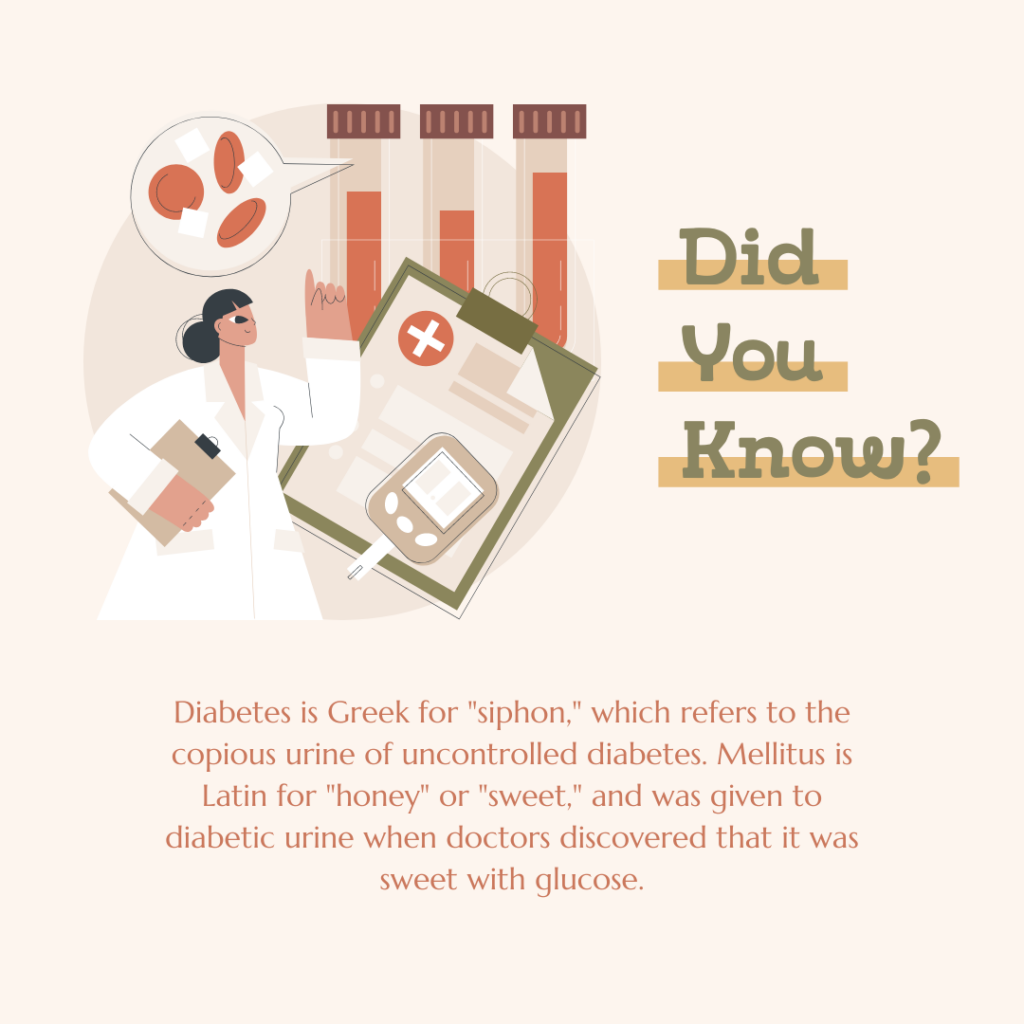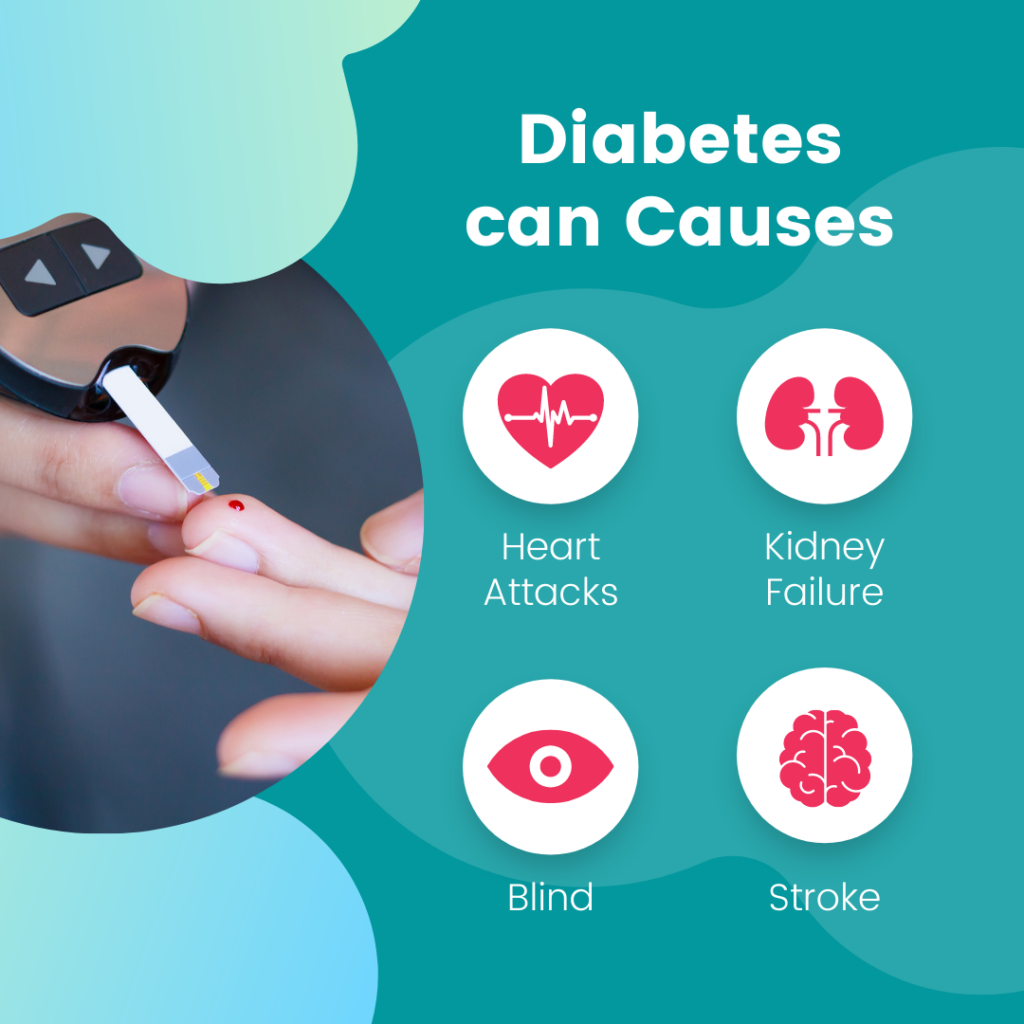What is Diabetes?
Diabetes is a chronic condition that affects the way the body processes sugar (glucose). There are two main types of diabetes: type 1 diabetes and type 2 diabetes.

Types of Diabetes
Type 1 diabetes is an autoimmune disorder in which the body’s immune system attacks and destroys the cells in the pancreas that produce insulin. Insulin is a hormone that helps to regulate blood sugar levels by allowing sugar to enter cells and be used for energy. Without insulin, sugar accumulates in the blood, leading to high blood sugar levels (hyperglycemia).
Type 2 diabetes is the most common form of diabetes, and it is often caused by a combination of genetic and environmental factors. In type 2 diabetes, the body becomes resistant to insulin or the pancreas does not produce enough insulin to meet the body’s needs. As with type 1 diabetes, this leads to high blood sugar levels.

Symptoms of diabetes:
Symptoms of diabetes may include
- increased thirst
- frequent urination
- fatigue
- blurred vision.
If left untreated, diabetes can lead to serious complications, including nerve damage, kidney disease, blindness, and an increased risk of heart attack and stroke.
Manage diabetes affectively
Diabetes is typically managed through a combination of lifestyle changes, such as eating a healthy diet and exercising regularly, and medication. Some people with diabetes may also need to monitor their blood sugar levels and inject insulin to help regulate their blood sugar.
To manage diabetes effectively, it’s important to work closely with a healthcare team and to follow a treatment plan as prescribed. This may involve making lifestyle changes, such as eating a healthy diet and exercising regularly, and taking medication as prescribed. It’s also important to monitor blood sugar levels and to address any issues or concerns with a healthcare professional.
In summary, diabetes is a chronic condition that affects the way the body processes sugar. It can lead to serious complications if left untreated, but it can be effectively managed through a combination of lifestyle changes and medication. Working closely with a healthcare team is key to managing diabetes and minimizing the risk of complications.
How Can a Healthy Person Get Diabetes?
Diabetes is a chronic condition that affects the way the body processes sugar (glucose). While certain risk factors, such as family history and age, can increase the likelihood of developing diabetes, it is possible for a healthy person to develop the condition. Here are a few ways that this can happen:
- Poor diet and lack of physical activity: A diet high in processed and sugary foods, as well as a lack of physical activity, can increase the risk of developing type 2 diabetes. These lifestyle factors can lead to weight gain and a decrease in insulin sensitivity, which can increase the risk of developing diabetes.
- Stress: Chronic stress can have a negative impact on overall health and may increase the risk of developing diabetes. Stress can lead to hormonal imbalances and changes in metabolism, which can contribute to the development of diabetes.
- Certain medications: Some medications, such as corticosteroids and antipsychotics, can increase the risk of developing diabetes. It’s important to discuss the potential risks and benefits of any medication with a healthcare professional.
- Pregnancy: Pregnancy can increase the risk of developing gestational diabetes, a type of diabetes that occurs during pregnancy and typically goes away after the baby is born. However, women who have gestational diabetes have an increased risk of developing type 2 diabetes later in life.
- Certain medical conditions: Certain medical conditions, such as pancreatitis and polycystic ovary syndrome (PCOS), can increase the risk of developing diabetes.
It’s important to be aware of the risk factors for diabetes and to take steps to reduce the risk of developing the condition. This may involve making lifestyle changes, such as eating a healthy diet and exercising regularly, and discussing any medications or medical conditions with a healthcare professional.
How Can a Healthy Person Get Type 1 Diabetes?
Type 1 diabetes is a chronic autoimmune disorder in which the body’s immune system attacks and destroys the cells in the pancreas that produce insulin. Insulin is a hormone that helps to regulate blood sugar levels by allowing sugar to enter cells and be used for energy. Without insulin, sugar accumulates in the blood, leading to high blood sugar levels (hyperglycemia).
While type 1 diabetes is often diagnosed in children and young adults, it can occur at any age. While the exact cause of type 1 diabetes is unknown, it is thought to be a combination of genetic and environmental factors. Here are a few ways that a healthy person may develop type 1 diabetes:
Genetic predisposition: Type 1 diabetes has a strong genetic component, meaning that if a family member has the condition, you may be at an increased risk of developing it. However, it is important to note that not everyone with a family history of type 1 diabetes will develop the condition.
Environmental factors: While the specific environmental factors that may contribute to the development of type 1 diabetes are not fully understood, research suggests that certain infections or toxins may play a role.
Autoimmune disorders: Some people may develop type 1 diabetes as a result of other autoimmune disorders, such as celiac disease or autoimmune thyroid disease.
How Can a Healthy Person Get Type 2 Diabetes?
Type 2 diabetes is the most common form of diabetes and is often caused by a combination of genetic and environmental factors. In type 2 diabetes, the body becomes resistant to insulin or the pancreas does not produce enough insulin to meet the body’s needs. This leads to high blood sugar levels (hyperglycemia).
While type 2 diabetes is more common in older adults, it can occur at any age, including in healthy individuals. Here are a few ways that a healthy person may develop type 2 diabetes:
Poor diet and lack of physical activity: A diet high in processed and sugary foods, as well as a lack of physical activity, can increase the risk of developing type 2 diabetes. These lifestyle factors can lead to weight gain and a decrease in insulin sensitivity, which can increase the risk of developing diabetes.
Stress: Chronic stress can have a negative impact on overall health and may increase the risk of developing type 2 diabetes. Stress can lead to hormonal imbalances and changes in metabolism, which can contribute to the development of diabetes.
Certain medications: Some medications, such as corticosteroids and antipsychotics, can increase the risk of developing type 2 diabetes. It’s important to discuss the potential risks and benefits of any medication with a healthcare professional.
Pregnancy: Pregnancy can increase the risk of developing gestational diabetes, a type of diabetes that occurs during pregnancy and typically goes away after the baby is born. However, women who have gestational diabetes have an increased risk of developing type 2 diabetes later in life.
Certain medical conditions: Certain medical conditions, such as pancreatitis and polycystic ovary syndrome (PCOS), can increase the risk of developing type 2 diabetes.
It’s important to be aware of the risk factors for type 2 diabetes and to take steps to reduce the risk of developing the condition. This may involve making lifestyle changes, such as eating a healthy diet and exercising regularly, and discussing any medications or medical conditions with a healthcare professional.
In summary, while certain risk factors can increase the likelihood of developing type 2 diabetes, it is possible for a healthy person to develop the condition. Risk factors for type 2 diabetes include a poor diet and lack of physical activity, stress, certain medications, pregnancy, and certain medical conditions. Taking steps to reduce the risk of type 2 diabetes can help to maintain overall health and well-being.
How Can a Person Avoid Diabetes?
Diabetes is a chronic condition that affects the way the body processes sugar (glucose). There are two main types of diabetes: type 1 diabetes and type 2 diabetes. While certain risk factors, such as family history and age, can increase the likelihood of developing diabetes, there are steps that a person can take to reduce the risk of developing the condition.

Here are a few ways that a person can avoid diabetes:
Maintain a healthy weight: Being overweight or obese can increase the risk of developing type 2 diabetes. To maintain a healthy weight, focus on eating a balanced diet that is rich in fruits, vegetables, and whole grains and that limits processed and sugary foods. In addition, engage in regular physical activity to help maintain a healthy weight.
- Eat a healthy diet: A diet that is rich in fruits, vegetables, and whole grains and that limits processed and sugary foods can help to reduce the risk of developing diabetes. It’s also important to limit the intake of saturated and trans fats, as these types of fats can contribute to insulin resistance.
- Exercise regularly: Regular physical activity can help to improve insulin sensitivity and reduce the risk of developing type 2 diabetes. Aim for at least 30 minutes of moderate-intensity physical activity, such as brisk walking, on most days of the week.
- Don’t smoke: Smoking can increase the risk of developing type 2 diabetes and can also worsen the complications of diabetes. If you smoke, talk to your healthcare professional about ways to quit.
- Get enough sleep: Getting enough sleep is important for overall health and can also help to reduce the risk of developing type 2 diabetes. Aim for 7-9 hours of sleep per night.




